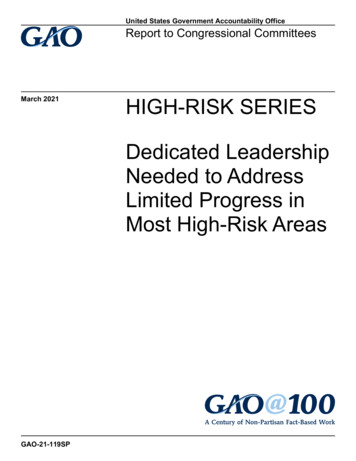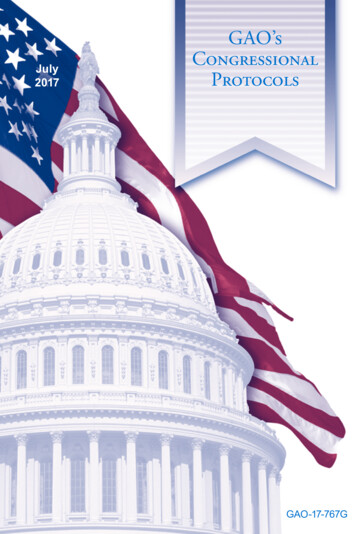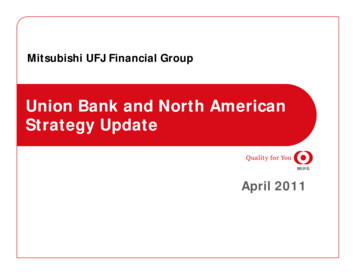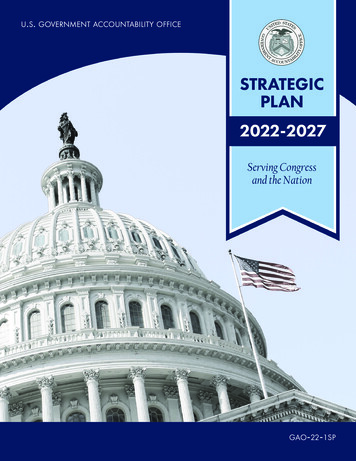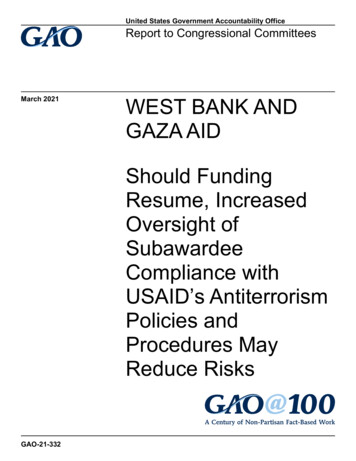
Transcription
United States Government Accountability OfficeReport to Congressional CommitteesMarch 2021WEST BANK ANDGAZA AIDShould FundingResume, IncreasedOversight ofSubawardeeCompliance withUSAID’s AntiterrorismPolicies andProcedures MayReduce RisksGAO-21-332
March 2021WEST BANK AND GAZA AIDHighlights of GAO-21-332, a report tocongressional committeesShould Funding Resume, Increased Oversight ofSubawardee Compliance with USAID's AntiterrorismPolicies and Procedures May Reduce RisksWhy GAO Did This StudyWhat GAO FoundSince 1993, the U.S. government hasprovided more than 6.3 billion inbilateral assistance to Palestinians inthe West Bank and Gaza. According toUSAID and State, because of acombination of policy and legal actions,ESF funding ceased as of January2019. USAID is primarily responsiblefor administering ESF assistance to theWest Bank and Gaza and ensuringcompliance with its antiterrorismpolicies and procedures.The U.S. government has provided assistance to Palestinians in the West Bankand Gaza to promote Middle East peace since 1993, in part through programsadministered by the U.S. Agency for International Development (USAID) andfunded by the Economic Support Fund (ESF). This funding ceased as of January31, 2019. By September 30, 2020, USAID had expended most of the ESF fundsthat were allocated for the West Bank and Gaza program in fiscal years 2015–2019. Specifically, USAID expended 487.3 million of the 540.4 million in fiscalyear 2015 and 2016 ESF assistance for the program. The Trump administrationreprogrammed the 230.1 million allocated for fiscal year 2017 to other programsand did not allocate funds for fiscal years 2018 and 2019. In December 2018, thePalestinian Authority stated that it would not accept assistance after January 31,2019, because of its concerns about the Anti-Terrorism Clarification Act of 2018.The act included provisions that could make recipients of ESF assistance subjectto U.S. lawsuits, according to officials from the Department of State (State) andUSAID. In January 2021, the Biden administration announced its intent toresume U.S. assistance to programs for the West Bank and Gaza.Appropriations acts for fiscal years2015–2019 include provisions for GAOto review the uses of ESF funds for theWest Bank and Gaza program. GAOwas also asked to review how ceasingthis assistance affected USAID’sstaffing resources. This reportexamines the (1) status of USAID’sESF assistance to the program forfiscal years 2015–2019, as ofSeptember 30, 2020; (2) steps USAIDtook for ongoing projects and staffinglevels when ESF assistance ceased;and (3) extent to which USAIDcomplied with its antiterrorism policiesand procedures for fiscal years 2015–2019. GAO reviewed laws and agencypolicies, procedures, documents, anddata, and assessed a generalizablesample of 245 subawards forcompliance with USAID’s antiterrorismpolicies and procedures.What GAO RecommendsGAO recommends that, should fundingresume, USAID (1) verify primeawardees have procedures to ensurecompliance with requirements beforemaking subawards and (2) conductpost-award compliance reviews in timeto make corrections before the awardsend. USAID agreed with therecommendations.View GAO-21-332. For more information,contact Latesha Love at (202) 512-4409 orlovel@gao.gov.USAID took several steps concerning ongoing projects and staffing levels at itsWest Bank and Gaza mission after assistance for the program ceased as ofJanuary 31, 2019. USAID ended 27 ongoing projects. USAID also stoppedrefilling authorized positions at its West Bank and Gaza mission, notifiedCongress of a planned reduction in force in May 2019, and placed about 50 staffon temporary assignment to other efforts. According to USAID, after receiving thenotification, congressional committees requested that USAID place a hold on theplanned reduction in force pending continued deliberations. While USAID has notterminated staff, the mission’s staff decreased 39 percent from December 2017to September 2020 because of post departures, transfers, and resignations.USAID’s antiterrorism policy and procedures for the West Bank and Gazaprogram outline three requirements for ESF recipients: vetting for many non-U.S.recipients of assistance, antiterrorism certifications for recipients of grants orcooperative agreements, and mandatory provisions intended to prevent financialsupport to terrorism in all prime awards and subawards. GAO found that, forfiscal years 2015–2019, USAID fully complied with all three requirements whenawarding prime awards, but did not consistently ensure that subawards were incompliance. In addition, GAO’s analysis of a generalizable sample of subawardsand USAID’s compliance reviews showed gaps in compliance for the vetting andmandatory provisions requirements at the subaward level. For example, GAO’sanalysis of USAID’s compliance reviews found that 13 of the 86 reports had oneor more instances of a prime awardee not incorporating the mandatoryprovisions, covering 420 subawards. USAID provided pre-award training to primeawardees on antiterrorism requirements for subawards, but did not verify thatawardees had procedures to comply with the requirements. Further, USAID’spost-award compliance reviews occurred, at times, after the subawards expired,which was too late to take corrective actions. Should ESF funding resume,verifying that prime awardees have such procedures and conducting post-awardcompliance reviews in time for corrections would better position USAID to reducethe risk of providing assistance to entities or individuals associated with terrorism.United States Government Accountability Office
ContentsLetter1BackgroundUSAID Expended Most of the ESF Funds Available for the WestBank and Gaza Program in FYs 2015–2019, Primarily forProject AssistanceUSAID Ceased Work on Projects and Took Steps to AddressMission Staffing Levels When ESF Assistance for the WestBank and Gaza Program Ceased as of January 31, 2019USAID Complied with Its Antiterrorism Policies and Procedures forPrime Awards but Did Not Consistently Ensure SubawardsWere in Compliance during FYs 2015–2019ConclusionsRecommendations for Executive ActionAgency Comments and Our Evaluation28373839Appendix IObjectives, Scope, and Methodology40Appendix IIUSAID West Bank and Gaza Mission’s Vetting Process for Awards46Appendix IIIEconomic Support Fund Obligations and Expenditures for ProjectAssistance and Payments to Palestinian Authority Creditors for FiscalYears 2015–201650Appendix IVProjects in the West Bank and Gaza That USAID Ended WhenEconomic Support Funds Ceased51Appendix VComments from USAID58Appendix VIGAO Contact and Staff Acknowledgments61Page i51420GAO-21-332 West Bank and Gaza Aid
Related GAO Products62TablesTable 1: Requests and Allocations of Economic Support Funds(ESF) for USAID’s West Bank and Gaza Program for FYs2015–2019, as of September 30, 2020Table 2: USAID Allocations, Obligations, and Expenditures ofEconomic Support Funds for Palestinians in the WestBank and Gaza, FYs 2015–2016, as of September 30,2020Table 3: USAID West Bank and Gaza Mission Staffing Changes,October 2017–September 2020Table 4: Prime Awardees’ Compliance and Noncompliance withMission Order 21 Vetting Requirements for SubawardsFunded during Fiscal Years 2015–2019Table 5: Compliance and Noncompliance with Mission Order 21Vetting Requirements for Subawards Funded duringFiscal Years 2015–2019Table 6: Prime Award Noncompliance with Mission Order 21Vetting Requirements for the West Bank and GazaProgram Identified by USAID’s Compliance ReviewReports, Fiscal Years 2015–2019Table 7: USAID West Bank and Gaza Mission’s ESF Obligationsand Expenditures for Project Assistance and Payments toCreditors, FYs 2015 and 2016, as of September 30, 2020Table 8: USAID Governance and Civic Engagement Projects inthe West Bank and Gaza That USAID Reported EndedPrematurely Because of the Cessation of EconomicSupport Funds, as of January 31, 2019Table 9: USAID Economic Growth and Infrastructure Projects inthe West Bank and Gaza That USAID Reported EndedPrematurely Because of the Cessation of EconomicSupport Funds, as of January 31, 2019Table 10: USAID Investing in the Next Generation Projects in theWest Bank and Gaza That USAID Reported EndedPrematurely Because of the Cessation of EconomicSupport Funds, as of January 31, 2019Table 11: USAID Program Support Projects in the West Bank andGaza That USAID Reported Ended Prematurely Becauseof the Cessation of Economic Support Funds, as ofJanuary 31, 2019Page ii1516233031325051535557GAO-21-332 West Bank and Gaza Aid
FiguresFigure 1: Map of the West Bank and Gaza and SurroundingCountriesFigure 2: Key Events Affecting Economic Support FundAssistance for USAID’s West Bank and Gaza Program,2018–2020Figure 3: USAID Economic Support Fund Obligations andExpenditures for the West Bank and Gaza Program,Fiscal Years 2015–2016 Combined, as of September 30,2020Figure 4: USAID West Bank and Gaza Mission Organization andStaff Positions Filled by Employment Position Type, as ofOctober 2017 and September 2020Figure 5: USAID’s Vetting Process for Awards for the West Bankand Gaza, as of January 31, 2019Page iii57182547GAO-21-332 West Bank and Gaza Aid
VSRIFSEC/CTStateTFAUSAIDUSDHUSPSCAutomated Directives SystemAnti-Terrorism Clarification Act of 2018Contracting/Agreement Officer’s Representativecongressional notificationEconomic Support FundFederal Acquisition RegulationForeign Service Nationalfiscal yearOverseas Contingency OperationsPalestinian AuthorityPalestine Liberation OrganizationProgram Support UnitPartner Vetting Systemreduction in forceOffice of Security’s Counterterrorism BranchDepartment of StateTaylor Force ActU.S. Agency for International DevelopmentU.S. Direct HireU.S. Personal Services ContractorThis is a work of the U.S. government and is not subject to copyright protection in theUnited States. The published product may be reproduced and distributed in its entiretywithout further permission from GAO. However, because this work may containcopyrighted images or other material, permission from the copyright holder may benecessary if you wish to reproduce this material separately.Page ivGAO-21-332 West Bank and Gaza Aid
Letter441 G St. N.W.Washington, DC 20548March 29, 2021The Honorable Christopher CoonsChairmanThe Honorable Lindsey GrahamRanking MemberSubcommittee on State, Foreign Operations, and Related ProgramsCommittee on AppropriationsUnited States SenateThe Honorable Barbara LeeChairwomanThe Honorable Hal RogersRanking MemberSubcommittee on State, Foreign Operations, and Related ProgramsCommittee on AppropriationsHouse of RepresentativesSince the signing of the Oslo Accords in 1993, the U.S. government hasprovided over 6.3 billion in bilateral assistance to Palestinians in theWest Bank and Gaza, primarily using funds appropriated through theEconomic Support Fund (ESF). 1 According to the Department of State(State), the U.S. government has viewed economic and humanitarianassistance provided to the Palestinians as promoting the economic andpolitical foreign policy interests of the United States by supporting MiddleEast peace negotiations and financing economic stabilization programs.The U.S. Agency for International Development (USAID), with overallforeign policy guidance from State, has primary responsibility foradministering ESF assistance for Palestinians in the West Bank andGaza. USAID has provided project assistance and debt relief payments toPalestinian creditors. For example, USAID’s assistance projects andactivities in the West Bank and Gaza are bound by federal laws,executive orders, and policies to ensure that the assistance does notprovide support to entities or individuals associated with terrorism.1In1993, the government of Israel and the Palestine Liberation Organization signed theOslo Peace Accords, which called for the withdrawal of Israeli forces from parts of theWest Bank and Gaza and affirmed the Palestinian right to self-government within thoseareas. According to State, the U.S. bilateral assistance provided since then includes fundsappropriated through ESF; International Narcotics Control and Law Enforcement;Nonproliferation, Antiterrorism, Demining, and Related Programs; and OverseasContingency Operations accounts.Page 1GAO-21-332 West Bank and Gaza Aid
Because of a combination of complex political and legal actions, as ofJanuary 31, 2019, the Trump administration suspended all bilateral aid tothe Palestinians, including ESF funding for the West Bank and Gazaprogram, according to State and USAID. During our review, the future ofthe program and staffing of USAID’s West Bank and Gaza missionremained uncertain, according to USAID and State officials. However, onDecember 20, 2019, Congress directed 75 million in bilateral ESFassistance for Palestinians in the West Bank and Gaza for fiscal year(FY) 2020, subject to certain conditions. 2 In addition, at a United Nationsmeeting on January 26, 2021, the U.S. Ambassador to the United Nationsannounced the Biden administration’s intent to resume U.S. assistancefor programs that support economic development and humanitarian aidfor Palestinians in the West Bank and Gaza. According to State,President Biden and the Secretary of State have made clear their intent torestart assistance.The annual consolidated appropriations acts for FYs 2015–2019 includedprovisions for GAO to review the treatment, handling, and uses of fundsprovided through the ESF account for the West Bank and Gaza, includingthe extent to which the funded projects and activities comply with certainantiterrorism and other requirements. 3 In addition, you asked us to reviewhow ceasing ESF assistance for the West Bank and Gaza programaffected USAID’s management of its staffing resources. This reportexamines the (1) status of USAID’s ESF assistance to the West Bank and2Among other statutory conditions, the Joint Explanatory Statement accompanying theFurther Consolidated Appropriations Act, 2020, 165 Cong. Rec. H11430 (Dec. 17, 2019),provided that these funds shall be made available if the Anti-Terrorism Clarification Act of2018 is amended to allow for their obligation. The ATCA was amended in part by theFurther Consolidated Appropriations Act, 2020, Pub. L. No. 116-94, Div. J, Title IX,§903(c)(1) (Dec. 20, 2019). These funds have an initial period of availability for obligationof 2 fiscal years. Funds obligated during this period remain available for deobligation andreobligation for an additional 4 years from the date when the availability of such fundswould otherwise have expired. After this period, the funds are no longer available for newobligations, but remain available for expenditure and valid adjustments for an additional 5fiscal years.3Consolidatedand Further Continuing Appropriations Act, 2015, Pub. L. No. 113-235, §7039(e) (Dec. 16, 2014); Consolidated Appropriations Act, 2016, Pub. L. No. 114-113, §7039(e) (Dec. 18, 2015); Consolidated Appropriations Act, 2017, Pub. L. No. 115-31, §7039(e) (May 5, 2017); Consolidated Appropriations Act, 2018, Pub. L. No. 115-141, §7039(e) (Mar. 23, 2018); and Consolidated Appropriations Act, 2019, Pub. L. No. 116-6, §7039(e) (Feb.15, 2019). Appropriations acts for FYs 2012, 2013, and 2014 includedsimilar provisions. We have reported on provisions in these mandates in the past. A list ofrelated GAO products is included at the end of this report.Page 2GAO-21-332 West Bank and Gaza Aid
Gaza program for FYs 2015–2019, as of September 30, 2020; 4 (2) stepsUSAID took concerning ongoing projects and USAID mission staffinglevels when ESF assistance for the West Bank and Gaza programceased as of January 31, 2019; and (3) extent to which USAID compliedwith its policies and procedures to ensure that ESF program assistanceprovided to the West Bank and Gaza program did not provide support toentities or individuals associated with terrorism during FYs 2015-2019.To determine the status of USAID’s ESF assistance to the West Bankand Gaza program for FYs 2015–2019, we reviewed FYs 2015–2019appropriations legislation, budget justification and State allocationdocuments, congressional notifications, and State and USAID financialdata as of September 30, 2020. In addition, we reviewed informationregarding USAID’s financial system and determined that the dataprovided from the system were sufficiently reliable for the purposes of ourreporting objectives. We also interviewed State and USAID officials andreviewed their written responses to our questions along with the relevantlaws and available documentation on the key events affecting ESFassistance, including the cessation of funding.To determine the steps USAID took concerning ongoing projects andmission staffing levels when ESF assistance ceased as of January 31,2019, we reviewed USAID data and corroborating project documentationon these projects, 5 including descriptions, project award start dates andoriginal end dates, total estimated costs, and obligated amounts. We alsoreviewed data and documentation provided by USAID on authorizedstaffing levels and the status of each staff member from October 2017through September 2020, including dates and reasons for departures,transfers, and resignations. In addition, we reviewed a congressionalnotification describing a planned reduction in force and data provided bythe USAID mission on temporary assignments of staff to other efforts. Wealso interviewed USAID West Bank and Gaza mission officials andreviewed their written responses to our questions on the steps taken.To determine the extent to which USAID complied with its policies andprocedures to ensure that ESF program assistance provided to the West4Accordingto USAID West Bank and Gaza mission officials, financial data were availableon a quarterly basis. Data as of September 30, 2020, were the most recently availabledata during our review.5Forthe purposes of this report, we use the term “projects” to include what USAIDsometimes interchangeably refers to as “programs,” “projects,” “initiatives,” and “activities”within the ESF-funded West Bank and Gaza program.Page 3GAO-21-332 West Bank and Gaza Aid
Bank and Gaza did not provide support to entities or individualsassociated with terrorism, we reviewed USAID’s antiterrorism policies andprocedures and examined relevant USAID records related to assistanceprograms. To determine whether program assistance complied withvetting, antiterrorism, and mandatory provision requirements, weexamined all 55 prime awards—which include contracts, grants, andcooperative agreements—that USAID awarded to its implementingpartners with FYs 2015–2016 ESF funding, before funding ceased. 6 Weassessed the extent to which USAID granted these awards in compliancewith its antiterrorism policies and procedures. Using data provided byUSAID, we also examined a random generalizable sample of 245subawards funded during FYs 2015–2019, which included contracts andgrants, and assessed the extent to which USAID prime awardees grantedthese awards in compliance with USAID’s vetting and antiterrorismcertification requirements. In addition, we asked USAID to provide allcompliance review reports and audit reports completed during FYs 2015–2019. We reviewed and analyzed all 86 compliance review reports and all215 financial audits that USAID provided for instances of noncompliancewith USAID’s antiterrorism policies and procedures for subawardees.USAID issued the compliance review reports between March 2015 andApril 2019 and the audit reports between June 2016 and November 2019.See appendix I for more information on our scope and methodology.We conducted this performance audit from December 2018 to March2021 in accordance with generally accepted government auditingstandards. Those standards require that we plan and perform the audit toobtain sufficient, appropriate evidence to provide a reasonable basis forour findings and conclusions based on our audit objectives. We believethat the evidence obtained provides a reasonable basis for our findingsand conclusions based on our audit objectives.6Forthe purposes of this report, we use the term “prime awardee” to refer to organizationsand individuals that directly receive USAID funding to implement contracts, grants, orcooperative agreements, and “subawardee” to refer to organizations and individuals thatreceive subcontracts or subgrants from prime awardees for work on U.S. assistanceprojects.Page 4GAO-21-332 West Bank and Gaza Aid
BackgroundThe West Bank and Gazaand USAID’s Role inProviding AssistanceThe West Bank and Gaza cover about 2,400 square miles and have acombined population of an estimated 4.8 million, as of July 2020. Figure 1shows the location of the West Bank and Gaza relative to surroundingcountries.Figure 1: Map of the West Bank and Gaza and Surrounding CountriesRoughly 60 percent of the West Bank is under Israeli civil and militarycontrol. The Palestinian Authority (PA) controls the remaining 40 percent,mainly the major Palestinian population centers and the areasimmediately surrounding them. Hamas has de facto control over Gaza.Since Hamas’s takeover of Gaza in June 2007, USAID has adjusted U.S.Page 5GAO-21-332 West Bank and Gaza Aid
assistance to Gaza to take into account the factional and geographicalsplit between Fatah and Hamas to comply with U.S. policy and U.S. law. 7According to USAID, since 1994, when USAID officially opened its WestBank and Gaza mission in Tel Aviv, Israel, USAID programs haveassisted 4 million Palestinians living in the West Bank and Gaza. Themission manages the ESF-funded West Bank and Gaza program, forwhich funding has ceased, as well as a smaller ongoing ConflictManagement and Mitigation program with the U.S. embassy in Israel. 8Because of a combination of complex political and legal actions, thefuture of the West Bank and Gaza program and staffing of USAID’s WestBank and Gaza mission remains uncertain, according to State andUSAID. Figure 2 provides a timeline of key events affecting ESFassistance for USAID’s West Bank and Gaza program from 2018 through2020.7Hamashas been designated a Foreign Terrorist Organization, a Specially DesignatedTerrorist, and a Specially Designated Global Terrorist by the U.S. government. Provisionsin annual appropriations acts have prohibited funding for assistance to Hamas, any entityeffectively controlled by Hamas, or any power-sharing government of which Hamas is amember or that results from an agreement with Hamas and over which Hamas exercisesundue influence. See Consolidated and Further Continuing Appropriations Act, 2015, Pub.L. No. 113-235, § 7040(f) (Dec. 16, 2014); Consolidated Appropriations Act, 2016, Pub. L.No. 114-113, § 7040(f) (Dec. 18, 2015); Consolidated Appropriations Act, 2017, Pub. L.No. 115-31, § 7040(f) (May 5, 2017); Consolidated Appropriations Act, 2018, Pub. L. No.115-141, § 7040(f) (Mar. 23, 2018); and Consolidated Appropriations Act, 2019, Pub. L.No.116-6, § 7040(f) (Feb. 15, 2019).8USAID’s West Bank and Gaza mission in Tel Aviv, Israel, jointly manages the ConflictManagement and Mitigation program with the U.S. embassy in Israel. The mission andembassy jointly invest in and manage Conflict Management and Mitigation grants. Thesegrants support Jewish and Arab citizens of Israel working on issues of common concern.The program is part of a worldwide effort to bring together individuals of differentbackgrounds in people-to-people reconciliation activities, according to USAID.Page 6GAO-21-332 West Bank and Gaza Aid
Figure 2: Key Events Affecting Economic Support Fund Assistance for USAID’sWest Bank and Gaza Program, 2018–2020Page 7GAO-21-332 West Bank and Gaza Aid
USAID’s AntiterrorismPolicies and ProceduresInclude Vetting,AntiterrorismCertifications, andMandatory ProvisionsIn response to federal laws and executive orders prohibiting assistance toentities or individuals associated with terrorism, USAID’s West Bank andGaza mission adopted in March 2006 a key administrative policydocument known as Mission Order 21. 9 The purpose of Mission Order 21,last amended in 2007, is to describe policies and procedures to ensurethat the mission’s program assistance does not inadvertently providesupport to entities or individuals associated with terrorism. Suchprocedures include (1) vetting, (2) obtaining antiterrorism certifications,and (3) including specific mandatory provisions in award documents. 10Subsequently, USAID has issued various notices to inform or remindprime awardees of their obligations as well as USAID procedures. Onesuch notice from 2010 provides that prime awardees are required toensure that applicable vetting approval is obtained before a subaward ismade, and mandatory provisions are included in subaward documents, asapplicable. 11 USAID is responsible for ensuring that Mission Order 21procedures are followed with regard to both prime awards and subawardsfor the West Bank Gaza mission assistance program. All awards for theWest Bank and Gaza program are required to have a reference toMission Order 21, according to USAID.9Suchlaws and executive orders include, in part, Executive Order 13224, which blocksproperty of individuals and entities designated as committing or posing a significant risk ofcommitting terrorist acts, and provisions in appropriations laws that prohibit fundingterrorists and require procedures to be established to ensure that assistance is notprovided to or through any individual or entity associated with terrorism. See Exec. OrderNo. 13224, 66 Fed. Reg. 49079, Sep. 23, 2001, codified as amended at 50 U.S.C. § 1701note; Foreign Operations, Export Financing, and Related Programs Appropriations Act,2006, Pub. L. No. 109-102, § 559 (Nov. 14, 2005). USAID’s West Bank and Gaza missionstated that it has conducted antiterrorism vetting since 2003 in response to statutoryrequirements.10In 2017, USAID issued but decided not to implement an addendum to Mission Order 21that would have expanded vetting requirements to include U.S.-based organizations andcertain key individuals of U.S. organizations’ field offices in the West Bank and Gaza,Israel, or the city of Jerusalem. According to USAID documents, in September 2017,USAID issued the addendum after the government of Israel charged a Gaza field officeemployee of a past U.S.-based prime awardee with diverting donor funding to Hamas’smilitary wing. USAID concluded that vetting of the prime awardee’s field-based keyindividuals might have revealed sufficient risk to warrant action by the mission. However,in November 2017, USAID delayed implementation of the addendum until the necessarystaff in Washington, D.C. was in place to manage the increase in vetting requests thatmay have resulted from implementation.11USAID, West Bank Gaza Mission Notice, “Reminder of Compliance Policies andProcedures,” 2010-WBG-10, June 9, 2010. For the purposes of this report, the term“Mission Order 21” includes clarifying guidance in USAID notices, when applicable.Page 8GAO-21-332 West Bank and Gaza Aid
VettingMission Order 21 requires that certain individuals and non-U.S.organizations undergo vetting. The vetting requirements apply to certaincontractors and subcontractors, recipients of grants and cooperativeagreements, trainees and students, and recipients of cash or in-kindassistance, with some exceptions. The vetting involves USAID’s vettingcenter checking the names of individuals and organizations and otheridentifying information against databases and other sources to determineif they have any alleged links to terrorism. USAID clears non-U.S.organizations by vetting their key individuals regardless of nationality,including U.S. citizens. 12 According to USAID, the vetting processprovides reasonable assurance that program assistance is “not providedto or through any individual, private or government entity, or educationalinstitution that is believed to advocate, plan, sponsor, engage in, or hasengaged in, terrorist activity.” See the following text box for moreinformation on vetting requirements and appendix II for a description ofthe USAID West Bank and Gaza mission’s vetting process.12MissionOrder 21 states that “key individuals” means: principal officers of theorganization’s governing body (e.g., chairman, vice chairman, treasurer, or secretary ofthe board of directors or board of trustees); (2) the principal officer and deputy principalofficer of the organization (e.g., executive director, deputy director; president, vicepresident); (3) the program manager or chief of party for the USAID-financed program;and (4) any other person with significant responsibilities for administration of USAIDfinanced activities or resources.Page 9GAO-21-332 West Bank and Gaza Aid
Mission Order 21 Vetting RequirementsMission Order 21 requires USAID’s West Bank and Gaza mission to vet the following: All non-U.S. prime awardee and subawardee organizations or individuals proposedfor a contract or subcontract above 25,000, except personal services contracts tobe awarded by USAID and awards involving vendors of goods or services acquiredby USAID contractors and grantees in the ordinary course of business for their ownuse, unless the total amount of rent under such an agreement exceeds 25,000.The 25,000 threshold is cumulative for multiple awards to the same organizationor individual within a rolling 12-month period. If an amendment would increase theamount of an award or subaward above 25,000, vetting would be required nomatter how many months have passed since the original award.All non-U.S. prime awardee and subawardee organizations or individuals (otherthan public international organizations) proposed to receive cash or in-kindassistance under a cooperative agreement, grant, or subgrant, regardless of thedollar amount.All non-U.S. individuals who receive USAID-financed training, study tours, orinvitational travel in the United States or third countries, regardless of
complied with its antiterrorism policies and procedures for fiscal years 2015- 2019. GAO reviewed laws and agency policies, procedures, documents, and data, and assessed a generalizable sample of 245 subawards for compliance with USAID's antiterrorism policies and procedures. What GAO Recommends GAO recommends that, should funding
